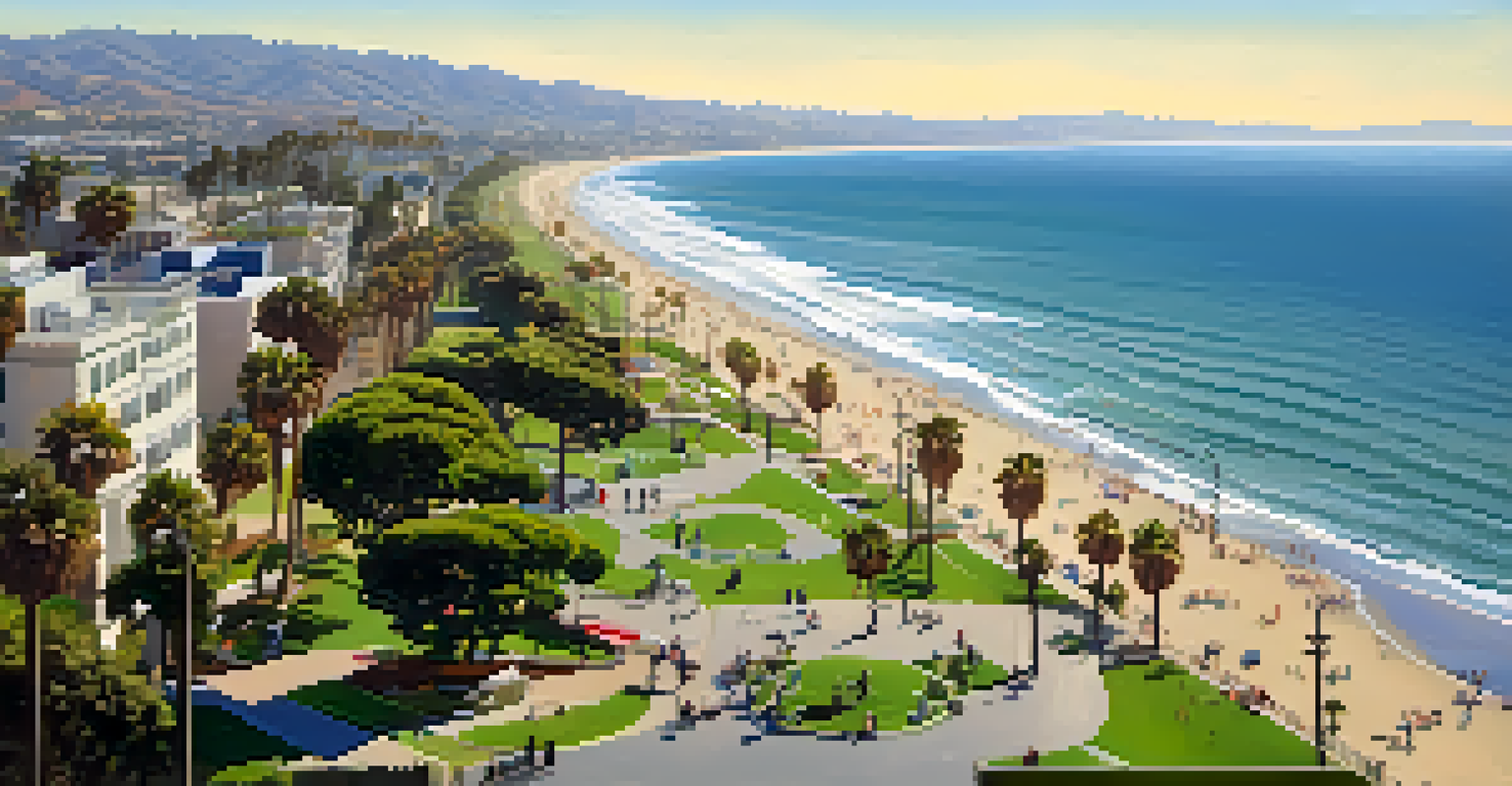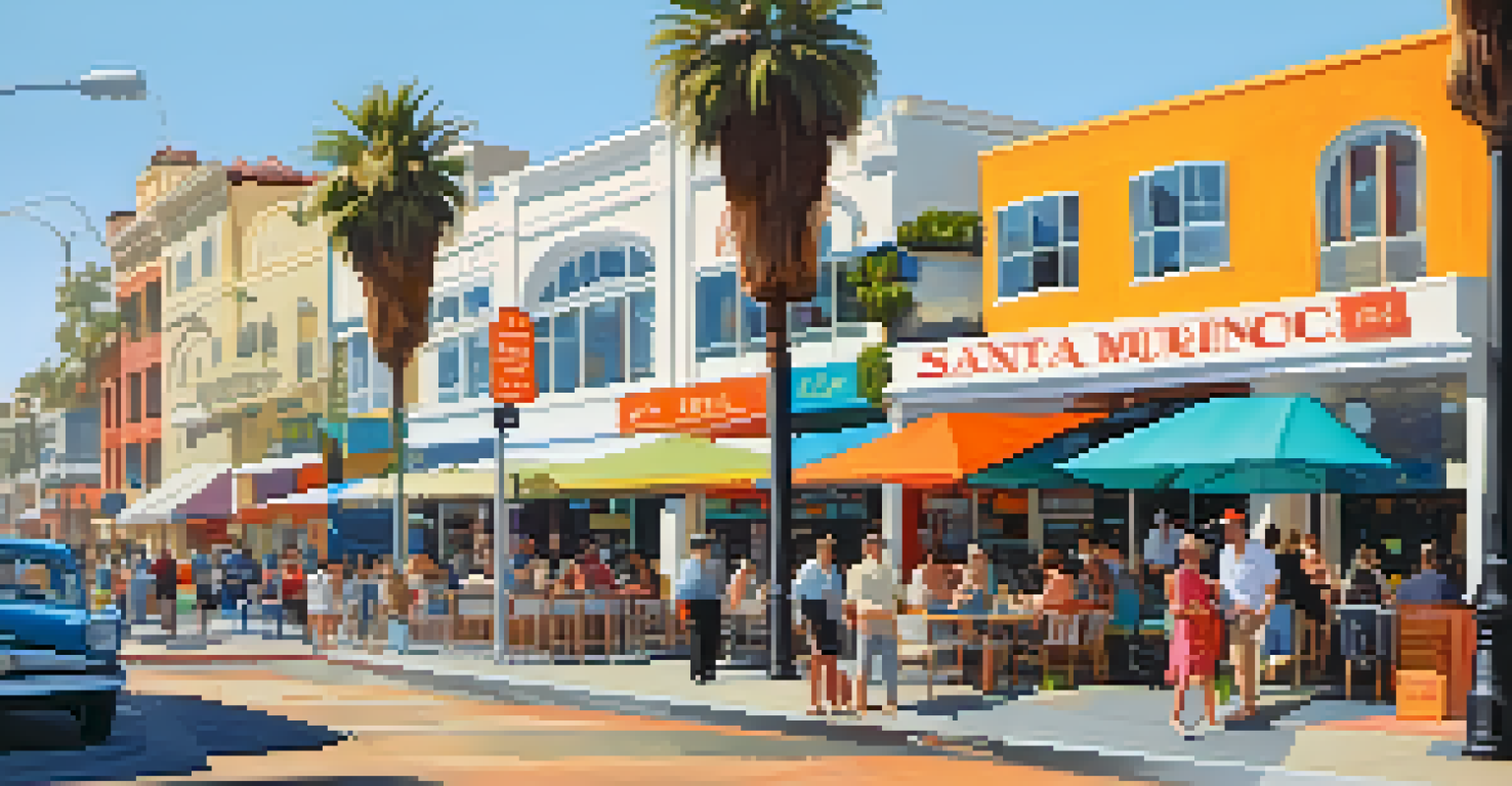Historical Context of Urban Planning in Santa Monica

The Early Days: Santa Monica's Founding and Growth
Santa Monica's history begins in the late 19th century, when it was founded as a small beachfront community. The arrival of the railroad in 1875 transformed Santa Monica into a popular tourist destination, drawing visitors seeking sun and surf. This influx of people prompted the need for organized urban planning, establishing the foundation for future city development.
The best way to predict the future is to create it.
In 1886, Santa Monica was officially incorporated, and its growth accelerated as more residents settled in the area. The original city layout was characterized by a grid pattern, emphasizing accessibility to the beach and public spaces. This early planning reflected a focus on creating a vibrant community centered around leisure and coastal activities.
As Santa Monica flourished, the need for infrastructure and services became apparent. The city began to develop essential facilities like schools, parks, and roads, setting the stage for more structured urban planning. This early period laid the groundwork for a city that would balance residential needs with its coastal charm.
The Influence of the City Beautiful Movement
In the early 20th century, the City Beautiful Movement emerged, influencing urban planning across the United States, including Santa Monica. This movement aimed to create aesthetically pleasing and organized urban spaces, highlighting parks, boulevards, and monumental architecture. In Santa Monica, this meant enhancing public areas to promote community engagement and well-being.

One notable example of this influence is Palisades Park, designed to offer stunning ocean views while providing a recreational space for residents and visitors alike. The park's design reflects the ideals of the City Beautiful Movement, showcasing the importance of green spaces in urban settings. Santa Monica's commitment to beautification during this era helped shape its identity as a coastal city.
Santa Monica's Urban Planning Evolution
Santa Monica's urban planning has evolved from its early days of organized community development to incorporating sustainability and community engagement.
This period also saw the introduction of zoning laws, guiding development and ensuring that residential, commercial, and recreational spaces coexisted harmoniously. The City Beautiful Movement not only left a lasting impact on Santa Monica's landscape but also paved the way for modern urban planning principles.
Post-War Expansion and Suburbanization Trends
After World War II, Santa Monica experienced significant growth as returning veterans settled in the area. This post-war boom led to a surge in housing developments, reflecting the national trend toward suburbanization. Families sought homes with yards and proximity to good schools, changing the urban landscape of Santa Monica.
Sustainability is no longer about doing less harm. It's about doing more good.
During this time, urban planning focused on accommodating the increasing population while maintaining the city's coastal charm. The city expanded its infrastructure, creating residential neighborhoods and commercial districts to meet the needs of its growing community. However, this rapid expansion also brought challenges, such as traffic congestion and the need for more public services.
To address these issues, city planners began to implement more comprehensive urban policies, prioritizing sustainable growth and community welfare. This period marked a shift towards considering the long-term impacts of development on Santa Monica's environment and quality of life.
Environmental Awareness and Sustainable Planning
As the environmental movement gained momentum in the 1970s, Santa Monica began to incorporate sustainability into its urban planning. Recognizing the importance of preserving natural resources and promoting green spaces, the city became a leader in environmental initiatives. This shift marked a significant turning point in how urban development was approached.
Santa Monica introduced various policies aimed at reducing environmental impact, such as promoting public transportation and implementing green building standards. These measures not only improved the city's ecological footprint but also enhanced residents' quality of life by creating healthier living environments. The emphasis on sustainability became a cornerstone of Santa Monica's urban planning philosophy.
Balancing Growth and Historic Charm
The city prioritizes balancing new developments with the preservation of its historical landmarks to maintain its unique coastal character.
The city's commitment to environmental stewardship is evident in projects like the Santa Monica Sustainable City Plan, which outlines goals for energy efficiency, waste reduction, and biodiversity preservation. This proactive approach to urban planning reflects the community's values and sets a precedent for other cities to follow.
Community Engagement in Urban Planning Decisions
In recent years, Santa Monica has prioritized community engagement in its urban planning processes. Recognizing that public input is essential for creating spaces that meet residents' needs, the city has implemented various outreach programs and forums. These initiatives allow community members to voice their opinions and actively participate in shaping their environment.
By involving residents in decision-making, Santa Monica fosters a sense of ownership and pride in the city's development. This collaborative approach has led to more thoughtful planning outcomes, as diverse perspectives help identify needs and opportunities. The city has successfully integrated community feedback into projects like the Downtown Specific Plan, ensuring that development aligns with residents' visions.
This emphasis on community engagement not only enhances transparency but also strengthens the bond between the city and its residents. Santa Monica's commitment to collaborative urban planning serves as a model for other cities striving for inclusive development practices.
Balancing Development with Historic Preservation
As Santa Monica continues to grow, balancing new development with the preservation of its historic character has become increasingly important. The city is home to several historic landmarks and neighborhoods that reflect its rich cultural heritage. Urban planners face the challenge of integrating modern needs while respecting these historical sites.
To address this, Santa Monica has established guidelines and policies for historic preservation, ensuring that new projects complement the city's architectural legacy. This approach helps maintain the unique charm that attracts visitors and residents alike. By prioritizing preservation, the city honors its past while paving the way for future growth.
Future Trends in Urban Resilience
As climate change poses challenges, Santa Monica's future urban planning will focus on resilience and integrating technology for sustainable living.
The ongoing dialogue between development and preservation illustrates the city's commitment to a well-rounded urban identity. Santa Monica strives to create a vibrant community that respects its history while embracing innovation and progress.
Future Trends in Santa Monica's Urban Planning
Looking ahead, Santa Monica's urban planning will likely be shaped by emerging trends and challenges. As climate change continues to impact coastal cities, adapting to rising sea levels and extreme weather events will be critical. Planners will need to develop resilient strategies that protect both the community and the environment.
Additionally, the growing emphasis on technology and smart city initiatives presents opportunities for Santa Monica to enhance urban living. Integrating data-driven solutions can improve public services, transportation, and energy efficiency, creating a more sustainable urban ecosystem. This shift towards technology will require careful planning to ensure equitable access for all residents.

Ultimately, the future of Santa Monica's urban planning lies in its ability to balance innovation with community values. By learning from its history and engaging residents in the planning process, Santa Monica can continue to evolve as a vibrant, sustainable coastal city.